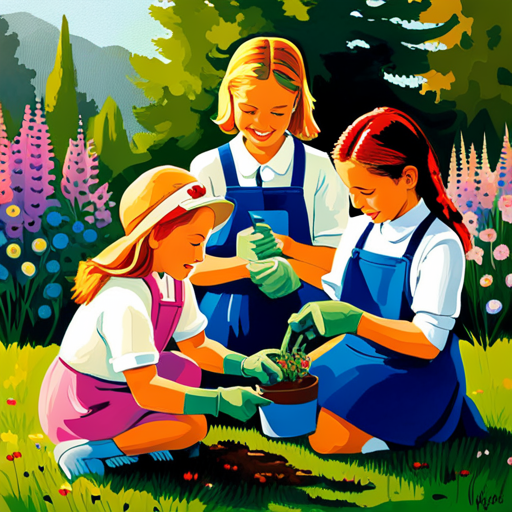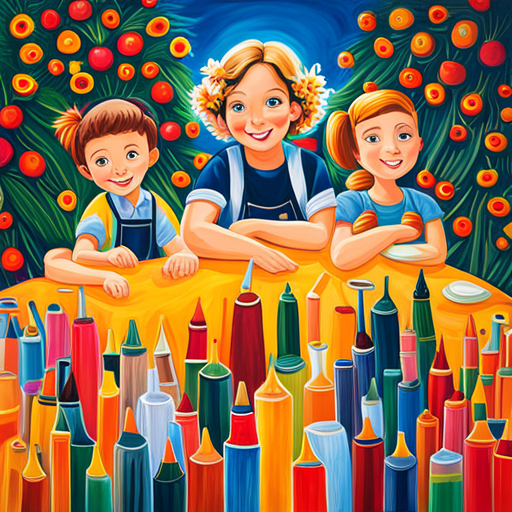"Cherishing Little Steps - A Haven for Baby and Family Journeys"
Eco-Friendly Activities for Kids
Are you looking for fun and engaging activities to teach your kids about the importance of taking care of the environment? Look no further!
Eco-friendly activities for kids are a great way to inspire a love for nature and instill eco-consciousness from an early age. One example is recycling crafts, where your little ones can turn everyday items into creative masterpieces while learning about the importance of reducing waste.
By actively participating in these activities, children not only gain a sense of accomplishment, but also develop a deeper understanding of how their actions can make a positive impact on the planet.
So, grab some recyclable materials, gather the little ones, and let the eco-friendly fun begin!
Key Takeaways
- Recycling and upcycling activities can help children develop creativity and a sense of responsibility towards the environment.
- Gardening and composting activities teach children about plant care, sustainability, and the benefits of organic gardening.
- Outdoor nature activities provide opportunities for children to connect with nature, appreciate its beauty, and contribute to its preservation.
- Sustainable cooking and eating activities promote eco-friendly practices, such as reducing meat consumption, supporting local farmers, and reducing food waste.
Recycling Crafts

Get creative and make fun crafts using recycled materials! Recycling crafts are a fantastic way to teach your kids about the importance of taking care of the environment while also unleashing their creativity.
One great option is to create crafts using recycled paper. Gather old newspapers, magazines, or even discarded drawings, and transform them into beautiful paper mache sculptures or colorful collages. Not only will you be reducing waste, but you’ll also be giving a new life to these materials.
Another exciting recycling craft idea is to use plastic bottles to create art. Plastic bottles are one of the most common types of waste, but they can be transformed into unique and eye-catching pieces. Cut them into different shapes, paint them with vibrant colors, and use them to create flower vases, pencil holders, or even bird feeders. Encourage your kids to think outside the box and let their imagination run wild with these materials.
By engaging in recycling crafts, you aren’t only fostering creativity but also teaching your children about the importance of reusing and repurposing materials. It’s a hands-on way to instill eco-friendly values in them while having fun together.
Gardening for Kids

To nurture your child’s love for nature and the environment, engage them in gardening activities that allow them to cultivate their own plants and take pride in their green thumbs. Gardening is a wonderful way for kids to connect with nature, learn about plant life cycles, and develop a sense of responsibility towards the environment. Here are some ideas to get your little ones excited about gardening:
| Garden Design | Plant Care |
|---|---|
| Let your child take charge of designing their own garden bed. Give them the freedom to choose the plants they want to grow and arrange them in a way that they find aesthetically pleasing. This will give them a sense of ownership and pride in their garden. | Teach your child about the importance of proper plant care. Show them how to water their plants, prune them when necessary, and protect them from pests. Encourage them to observe their plants closely and notice any changes in growth or health. This will help them develop a keen eye for plant care and understand the needs of different plants. |
| Create a theme garden with your child, such as a butterfly garden or a pizza garden. This will make the gardening experience more fun and educational. | Show your child how to create a compost bin and explain the benefits of composting. Teach them how to make their own organic fertilizer using kitchen scraps and yard waste. This will teach them the importance of recycling and reducing waste. |
| Get creative with garden decorations. Encourage your child to make their own wind chimes, stepping stones, or scarecrows to add a personal touch to their garden. | Teach your child about the importance of biodiversity and the role of pollinators in garden ecosystems. Plant flowers that attract bees, butterflies, and other beneficial insects. Explain how these creatures help in pollination and contribute to a healthy garden. |
DIY Bird Feeders

Make a bird feeder using simple materials to attract feathered friends to your child’s garden. It’s a fun and eco-friendly activity that won’t only bring joy to your little ones but also encourage bird watching and nature photography. Here are three easy ideas to get you started:
-
Pinecone Feeder:
Collect pinecones from your backyard or a nearby park. Tie a string around the top of the pinecone, leaving a long tail for hanging. Spread peanut butter all over the pinecone and roll it in birdseed. Hang it from a tree branch and watch as the birds flock to enjoy the tasty treat. -
Milk Carton Feeder:
Rinse out an empty milk carton and let it dry. Cut a small hole near the bottom of one side. Insert a thin wooden dowel through the carton, making sure it sticks out on both sides. Fill the carton with birdseed through the top opening. Hang it from a tree or attach it to a pole, and wait for the birds to come and perch on the dowel to eat. -
Orange Cup Feeder:
Cut an orange in half and scoop out the fruit. Pierce four holes near the top edge of each half. Thread a string through the holes and tie the ends together to create a hanging loop. Fill each half with birdseed and hang them in your garden. The bright colors and sweet scent of the oranges will attract birds in no time.
These DIY bird feeders won’t only provide nourishment for our feathered friends but also create opportunities for bird watching and capturing beautiful moments with nature photography. So, gather your materials and get ready to enjoy the wonders of the avian world right in your own backyard.
Nature Scavenger Hunt

Embark on an exciting adventure as you search for treasures in nature with a thrilling Nature Scavenger Hunt. This outdoor exploration activity is perfect for kids who love to explore and discover the wonders of the natural world. As you venture into the great outdoors, you will have the opportunity to engage with nature in a fun and educational way.
To get started, create a checklist of items or things you want to find during your scavenger hunt. Here’s a sample checklist to help you get inspired:
| Column 1 | Column 2 |
|---|---|
| Pinecone | Smooth rock |
| Feather | Acorn |
| Wildflower | Moss |
| Animal track | Fallen leaf |
As you search for these items, take the opportunity to observe and appreciate the beauty of nature around you. Encourage creativity by incorporating nature crafts into your hunt. For example, you can use the pinecones and fallen leaves you find to create unique artworks or decorations.
Upcycling Projects

Get ready to get creative and give new life to old items with some exciting upcycling projects for kids! Upcycling is a great way to teach children about the importance of reusing and reducing waste while having fun.
Here are three DIY home decor ideas and repurposing clothes projects that your little ones will love:
-
T-shirt Tote Bag: Transform an old t-shirt into a trendy and eco-friendly tote bag. Simply cut off the sleeves and neckline, then sew the bottom shut. Add some colorful fabric paint or patches for a personalized touch.
-
Glass Jar Lanterns: Turn empty glass jars into beautiful lanterns. Clean the jars thoroughly, then paint them in vibrant colors. Place a tea light candle inside and watch as the lanterns cast a warm and cozy glow.
-
CD Mosaic Art: Don’t throw away those old CDs! Instead, break them into small pieces and use them to create a stunning mosaic. Let your child’s imagination run wild as they arrange the pieces into a unique design on a canvas or wooden board.
These upcycling projects not only encourage creativity but also teach kids the value of repurposing and reducing waste. So gather your materials and get ready to embark on a fun and eco-friendly adventure!
Composting Fun
Start your composting journey and learn the benefits of recycling organic waste with these simple and rewarding activities for kids. Composting isn’t only great for the environment, but it also teaches kids about the importance of reducing waste and taking care of our planet.
One fun activity to introduce kids to composting is setting up an indoor compost bin. This allows them to see firsthand how organic waste can be transformed into nutrient-rich soil. Start by finding a small container with a lid, such as a plastic bin or a bucket. Place it in a convenient spot in your home, like the kitchen or a utility room. Then, explain to your kids that they can add fruit and vegetable scraps, coffee grounds, and eggshells to the bin. Over time, these materials will break down and turn into compost.
As your kids watch the transformation happen, they’ll learn about the benefits of composting. Compost can enrich soil, help retain moisture, and reduce the need for chemical fertilizers. It’s a natural way to improve the health of plants and create a sustainable gardening practice.
Planting Trees

When you plant trees, you’re actively contributing to the health of the environment and creating a greener future. Here are three tree planting benefits and techniques to help you get started:
-
Environmental Benefits: Trees play a crucial role in combating climate change by absorbing carbon dioxide and releasing oxygen. They also provide shade, reducing the need for air conditioning, and help prevent soil erosion. By planting trees, you’re helping to create a healthier and more sustainable planet.
-
Social Benefits: Trees not only beautify our surroundings but also improve our well-being. They create a calming and peaceful environment, reducing stress and promoting mental health. Additionally, trees provide habitat for wildlife and enhance biodiversity, making our communities more vibrant and enjoyable.
-
Tree Planting Techniques: To ensure successful tree planting, follow these steps:
- Choose the right tree species for your climate and soil conditions.
- Dig a hole that’s wide and deep enough to accommodate the tree’s roots.
- Gently remove the tree from its container, loosen the roots, and place it in the hole. Backfill with soil, ensuring the tree is upright and stable.
Ocean Cleanup Activities

By actively participating in ocean cleanup activities, you can make a direct impact on preserving marine ecosystems and protecting the health of our oceans. Beach cleanups, in particular, are a great way to contribute to marine wildlife conservation. Not only do they help remove harmful debris from the shoreline, but they also prevent it from entering the ocean and causing further harm to marine life.
To emphasize the importance of beach cleanups, take a look at the table below:
| Benefits of Beach Cleanups |
|---|
| Removal of harmful debris from the shoreline |
| Prevention of debris from entering the ocean |
| Protection of marine life and ecosystems |
By participating in beach cleanups, you are actively taking part in the conservation of marine wildlife. It is a hands-on activity that allows you to see the direct impact of your efforts. Imagine the satisfaction of knowing that you have helped create a safer environment for marine animals to thrive in.
Not only are beach cleanups beneficial for marine life, but they also provide an opportunity for you to connect with nature and enjoy the beauty of the ocean. So grab a pair of gloves and a trash bag, gather your friends or family, and head to the beach for a rewarding and impactful cleanup activity. Together, we can make a difference in preserving the health and beauty of our oceans for future generations.
Sustainable Cooking Experiments

To continue your eco-friendly journey, incorporate sustainable cooking experiments into your routine, allowing you to make a positive impact on the environment while enjoying delicious meals.
Eco-friendly cooking involves using sustainable food options and adopting practices that reduce waste and promote conservation. Here are three ideas to get you started:
-
Meatless Mondays: Dedicate one day a week to creating meatless meals. This simple change can significantly reduce your carbon footprint, as the meat industry is a major contributor to greenhouse gas emissions. Explore plant-based recipes like lentil burgers, vegetable stir-fries, or chickpea curries. Not only will you be helping the environment, but you’ll also discover new flavors and textures.
-
Farm-to-Table: Support local farmers and reduce the carbon emissions associated with long-distance transportation by sourcing your ingredients from nearby farms or farmers’ markets. When you buy directly from farmers, you can ensure that your food is grown sustainably without harmful pesticides or excessive packaging. Plus, you’ll enjoy the freshest and most flavorful produce available.
-
Composting: Create a composting system in your kitchen to reduce food waste. Instead of throwing away vegetable scraps, coffee grounds, and eggshells, transform them into nutrient-rich soil for your garden. Composting not only reduces landfill waste but also helps enrich the soil, promoting healthier plant growth.
Eco-Friendly Art Projects

Get creative with eco-friendly art projects that will engage and inspire your kids to explore their artistic talents while caring for the environment. There are many fun and exciting ways to incorporate eco-friendly practices into your child’s art projects.
When it comes to painting, you can introduce your kids to eco-friendly painting techniques. Instead of using traditional paints that contain harmful chemicals, opt for natural alternatives like vegetable-based dyes or homemade paints using ingredients like flour, water, and food coloring. Not only are these safer for your children, but they’re also better for the environment.
Another eco-friendly art project idea is creating sculptures using recycled materials. Encourage your kids to think outside the box and transform everyday objects into works of art. They can use old cardboard boxes, plastic bottles, and even scrap metal to create unique sculptures. Not only will this teach them about the importance of recycling, but it will also spark their creativity and imagination.
By engaging in eco-friendly art projects, your kids won’t only develop their artistic skills but also gain a deeper understanding and appreciation for the environment. It’s a win-win situation, where they can have fun while making a positive impact on the planet.
Frequently Asked Questions
What Are Some Examples of Materials That Can Be Used for Recycling Crafts?
You can create amazing crafts with recycled materials. For instance, you can make beautiful artwork using recycled paper and turn empty plastic bottles into fun planters. It’s a great way to help the environment and have fun!
How Can I Involve My Kids in Gardening Activities?
You can involve your kids in gardening activities by showing them the benefits of gardening for children. Create a kid-friendly garden with colorful flowers and easy-to-grow vegetables. It’s a fun and educational way to teach them about nature and sustainability.
What Are Some Easy DIY Bird Feeder Ideas for Kids?
Looking for easy DIY bird feeder ideas for kids? Get creative with materials like recycled bottles or pine cones. It’s a fun way to attract birds to your backyard and teach them about nature. Don’t forget to include bird watching tips too!
How Can I Organize a Nature Scavenger Hunt for Kids?
To organize a nature scavenger hunt for kids, gather a list of items found in nature, like leaves, rocks, or flowers. Hide them in a park or backyard, and let the kids explore and find them. It’s a fun and educational activity for everyone!
What Are Some Creative Ways to Upcycle Household Items?
You can get creative and repurpose household items in so many ways! Try turning old jars into candle holders, or transforming an old ladder into a bookshelf. The possibilities are endless!
Conclusion
So there you have it, a world of eco-friendly activities for kids that not only teach them about the importance of taking care of our planet, but also provide endless hours of fun and creativity.
These activities allow children to connect with nature, learn about recycling and upcycling, and even make a positive impact on the environment.
By engaging in these activities, children become environmental stewards, helping to create a better, greener future for all.
Let’s inspire the next generation to love and protect our planet!



Your style is really unique in comparison to other people I have read stuff from.
Thank you for posting when you have the opportunity, Guess I will just bookmark this blog.
Check out my web blog … vpn special coupon
It’s very effortless to find out any matter on web as compared
to textbooks, as I found this piece of writing at this web page.
Feel free to surf to my web page :: vpn special coupon
Thank you for the auspicious writeup. It in fact used to be
a amusement account it. Look complex facebook vs eharmony to find love online far
delivered agreeable from you! By the way, how can we be in contact?
Its like you read my thoughts! You seem to understand
so much approximately this, such as you wrote the e-book in it or something.
I feel that you could do with a few percent to force the message house a little bit, however instead of that,
this is wonderful blog. A great read. I’ll definitely
be back.
My homepage – eharmony special coupon code 2024
Thanks for finally talking about > Eco-Friendly Activities for Kids – nordvpn special coupon code 2024